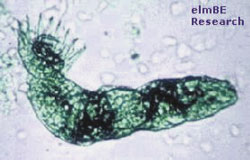|

Gill Flukes
Type:
Parasitic
>>caused by gill flukes, Dactylogyrus, small trematodes
or worm-like parasites that grow up to 2 mm in length
>> Dactylogyrus
is monogean, i.e., it needs only one host to complete its
entire life cycle
>>
dactylogyrids, which are egg-layers, have a scalloped head and
visible eyespots
>>
flukes anchor themselves to the koi using hooks at one end of
their body
>>
another commonly encountered fluke in koi is the
gyrodactylus, which
differs from the dactylogyrus by having a V-shaped head, no
eyespots, and giving live birth
Symptoms:
>> presence of gill flukes on the gills and body
>> labored breathing
>> swimming in jerky motions
>> gill hyperplasia and increased mucus
>> long periods of rest at the bottom of the pond with clamped
fins
>> reddening of some focal areas
>> can create entry points for secondary bacterial infections,
which in turn can lead to gill diseases and ulcers
Remedies:
>>
a skin scrape or biopsy is needed to make a definite diagnosis
of gill flukes
>>
gill flukes are more difficult to treat than skin flukes
>> regular salt baths, as well as special,
high-dose treatments with malachite green and formalin may
produce results
>>
organophosphates such as masoten may
be required for severe cases |

